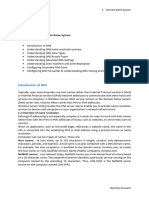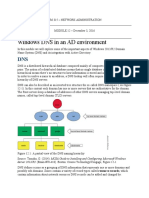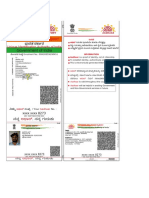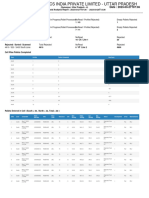DNS Zones Explained
DNS Zones Explained
Uploaded by
Fantabulous SixtyEightCopyright:
Available Formats
DNS Zones Explained
DNS Zones Explained
Uploaded by
Fantabulous SixtyEightCopyright
Available Formats
Share this document
Did you find this document useful?
Is this content inappropriate?
Copyright:
Available Formats
DNS Zones Explained
DNS Zones Explained
Uploaded by
Fantabulous SixtyEightCopyright:
Available Formats
DNS Zones Explained When someone types in the domain to your website on their browser: In the background, this
request is being routed to a nameserver, which in turn routes the request to the DNS zone that resides on your server. This DNS zone is responsible for your page appearing in a browser. There are several different types of information that are stored within a DNS zone. The address field contains the address mapping information for your IP address. This means that when a request for your domain is made, the DNS zone contains the information that is required for your browser to find your IP address. This IP address, even if it is shared with other users, is assigned to your domain name when you set up your nameserver. Each IP address would be mapped to a specific domain name or URL. It functions in much the same way as typing in a sites IP address in your browser, but it is much easier to remember a URL than it is to remember an IP address. This mapping field simply converts the domain name into the correct IP address. In addition to the address field in your DNS zone, the correct nameserver for your domain will be included. This nameserver must match the one that you had assigned to your domain for the process to work correctly. Your hosting company will provide you with this information but you will need to make sure that you have entered in the correct nameserver on your own, unless your hosting company is also the registrar of your domain.
The DNS Zone file The DNS Zone file is the representation of the DNS Zone - it is the actual file, which contains all the records for a specific domain. In a DNS Zone file, each line can hold only one record, and each DNS Zone file must start with the TTL (Time to Live), which specifies for how long the records should be kept in the DNS Server's cache. The other mandatory record for a DNS Zone file is the SOA (Start of Authority) record - it specifies the primary authoritative name server for the DNS Zone. After these two records are specified, additional records, such as A or NS records, can be added. When adding a record for a hostname, the hostname must end with a period (.). Hostnames, which do not end with a period, are considered relative to the main domain name, for which the DNS Zone was created. For example, when specifying the "www" record, there is no need to place a period after it. Comments in the DNS Zone file must be started with a semicolon (;) and the start of a multiple line comment is represented by brackets ("("), and comments must again start with a semicolon. When the multiple lines end, they must be closed again with a bracket (")"), placed on a single line.
DNS Records
SOA Record or "Start of Authority Record" Specifies the DNS server providing authoritative information about an Internet domain, the email of the domain administrator, the domain serial number, and several timers relating to refreshing the zone.
CNAME or "Canonical Name" (CNAME) Record is used to define an alias hostname. A "CNAME" record takes this format: alias.domain.name IN CNAME otherhost.domain.name.
This defines alias.domain.name as an alias for the host whose canonical (standard) name is otherhost.domain.name.
"A" Record An A record gives you the IP address of a domain. That way, users that try to go to www.example.com will get to the right IP address. An A record or "Address Record" maps a hostname to a 32-bit IPv4 address. An "A" Record takes this format (example): Name TTL TYPE DATA ftp.domain.com 43200 A IP Address (mt) Media Temple DNS Zone files are written with a "wildcard" entry, that looks like this: *.domain.com IN A xxx.xxx.xxx.xxx The x's represnt your particular IP address. The star takes "anything" .domain.com and points it to your server's IP address. This way, if someone mistakenly types too many or too few w's, they'll still see your website. This is also useful for setting up subdomains on your server, relieving you of the duty of adding an additional "A" record for the subdomain.
NS Record or "Name Server Record" Maps a domain name to a list of DNS servers authoritative for that domain. In this case, for (mt) Media Temple purposes would be: ns1.mediatemple.net ns2.mediatemple.net
You might also like
- Exercise VLSM ResultDocument7 pagesExercise VLSM ResultRoger LeonNo ratings yet
- DNSDocument9 pagesDNSpkkNo ratings yet
- DNS - How DNS Works and Most Common DNS RecordsDocument26 pagesDNS - How DNS Works and Most Common DNS RecordsdakilokicaNo ratings yet
- Domain Name SystemDocument9 pagesDomain Name Systemviruss gamingNo ratings yet
- DNS RecordsDocument10 pagesDNS Recordsamlesh80No ratings yet
- How Does The DNS Process Work?: Domain Name SystemDocument5 pagesHow Does The DNS Process Work?: Domain Name SystemAppu 24No ratings yet
- DNS QuestionsDocument3 pagesDNS QuestionsSreenu ReddyNo ratings yet
- Dns RecordsDocument6 pagesDns Recordsbuild.test456No ratings yet
- Domain Name System: Window Server 2012 R2Document46 pagesDomain Name System: Window Server 2012 R2Rajat RajputNo ratings yet
- DNSDocument5 pagesDNSDeepakwedNo ratings yet
- Unit 5 CNDocument23 pagesUnit 5 CNGovardhan KonukatiNo ratings yet
- The DNS System Consists of Three Components: DNS Data (Called Resource Records), Servers (Called Name Servers), and Internet Protocols For Fetching Data From The ServersDocument11 pagesThe DNS System Consists of Three Components: DNS Data (Called Resource Records), Servers (Called Name Servers), and Internet Protocols For Fetching Data From The ServersjavedcgNo ratings yet
- DNS Record RefDocument2 pagesDNS Record RefPSGNo ratings yet
- DNS (Domain Name System)Document11 pagesDNS (Domain Name System)gmaheshreddy229No ratings yet
- DNS FAQsDocument21 pagesDNS FAQsWaseem RajaNo ratings yet
- Domain Name System (DNS) and Amazon Route 53: Naresh I Technologies Amazon Web Services Avinash Reddy TDocument25 pagesDomain Name System (DNS) and Amazon Route 53: Naresh I Technologies Amazon Web Services Avinash Reddy Tma3gr8No ratings yet
- Domain Name SystemDocument19 pagesDomain Name SystemVivek KichusreeNo ratings yet
- 3 DNSDocument11 pages3 DNSGangaNo ratings yet
- DNSDocument18 pagesDNSraghavsarikaNo ratings yet
- DNS GlossaryDocument4 pagesDNS GlossarySreekumar PgNo ratings yet
- Presentation of Domain Name SystemDocument33 pagesPresentation of Domain Name SystemPiyushank GuptaNo ratings yet
- DNSDocument9 pagesDNSMantri SridharNo ratings yet
- DNSDocument31 pagesDNSAndrew BunaladeNo ratings yet
- Mengevaluasi DNS ServerDocument6 pagesMengevaluasi DNS ServerUtin HarlinaNo ratings yet
- DNS Questions: In-Addr - ArpaDocument21 pagesDNS Questions: In-Addr - ArpaWaseem RajaNo ratings yet
- DNS Record TypesDocument2 pagesDNS Record Typessureshpandey06No ratings yet
- DNS AdDocument6 pagesDNS AdabdallaNo ratings yet
- Day 5 - DNSDocument2 pagesDay 5 - DNSShivdev KumarNo ratings yet
- DNS SeminarDocument30 pagesDNS SeminarNA KarthikNo ratings yet
- Implementing DNSDocument40 pagesImplementing DNSSantoshSangroulaNo ratings yet
- CSS Unit V Internet Infrastructure SecurityDocument12 pagesCSS Unit V Internet Infrastructure SecurityAditya KesarwaniNo ratings yet
- Introduction of DNS in Windows ServerDocument9 pagesIntroduction of DNS in Windows ServerNileshNo ratings yet
- 6.2 DNS OperationsDocument7 pages6.2 DNS OperationsIslam DeifNo ratings yet
- BÀI 5: 1. DNS Zone Là Gì?Document6 pagesBÀI 5: 1. DNS Zone Là Gì?thuy3677No ratings yet
- Chapter 4 - Name Resolution: at A GlanceDocument8 pagesChapter 4 - Name Resolution: at A Glanceghar_dashNo ratings yet
- Linux Dns Server ExposeDocument14 pagesLinux Dns Server ExposeINFO TECNo ratings yet
- DNS Server Configuration: Introduction To The Domain Name SystemDocument21 pagesDNS Server Configuration: Introduction To The Domain Name SystemDavid SandilNo ratings yet
- What's in A (Domain) Name?Document17 pagesWhat's in A (Domain) Name?Ryda SNo ratings yet
- Domain Name System (DNS)Document13 pagesDomain Name System (DNS)suneelkluNo ratings yet
- DNS Interview QuestionsDocument3 pagesDNS Interview QuestionsSmile EverNo ratings yet
- TCP/IP Fundamentals For Microsoft WindowsDocument24 pagesTCP/IP Fundamentals For Microsoft WindowsJoel MangallayNo ratings yet
- Netapp DNS - DFDocument32 pagesNetapp DNS - DFNarit KlinchanNo ratings yet
- DNS RecordsDocument4 pagesDNS RecordsvineethNo ratings yet
- Idex Carlos Salazar RomeroDocument15 pagesIdex Carlos Salazar RomeroJan Pool Lopez YarlequeNo ratings yet
- Category Status Test Name InformationDocument7 pagesCategory Status Test Name InformationPixelPatriotNo ratings yet
- CH 10 DNS AssisgnmentDocument6 pagesCH 10 DNS Assisgnmentyfv181164No ratings yet
- NSA LO1 - ThabangDocument42 pagesNSA LO1 - ThabangThabang Llyod MompatiNo ratings yet
- A Crash Course in DNS - ByteByteGo NewsletterDocument15 pagesA Crash Course in DNS - ByteByteGo NewsletterSusantoNo ratings yet
- DNS Server:: Com Google MailDocument6 pagesDNS Server:: Com Google MailAyanNo ratings yet
- Dns PrintDocument1 pageDns Printsatheesh GNo ratings yet
- Host A Record: A CNAME (Canonical Name)Document6 pagesHost A Record: A CNAME (Canonical Name)Kundan SinghNo ratings yet
- Welcome: - Basics of DnsDocument21 pagesWelcome: - Basics of DnscsdhimanNo ratings yet
- Evaluation of Some SMTP Testing, Email Verification, Header Analysis, SSL Checkers, Email Delivery, Email Forwarding and WordPress Email ToolsFrom EverandEvaluation of Some SMTP Testing, Email Verification, Header Analysis, SSL Checkers, Email Delivery, Email Forwarding and WordPress Email ToolsNo ratings yet
- Internet Web Programming N Srinibha Rao 19BCI0245: Explain About The Domain Name SystemDocument6 pagesInternet Web Programming N Srinibha Rao 19BCI0245: Explain About The Domain Name SystemSrinibha RaoNo ratings yet
- Domain Name System - Internet PDFDocument8 pagesDomain Name System - Internet PDFp-jornNo ratings yet
- What Is DNS: There Are 4 DNS Servers Involved in Loading A WebpageDocument9 pagesWhat Is DNS: There Are 4 DNS Servers Involved in Loading A Webpagepreenu mittanNo ratings yet
- Hostinger DNS Zone Editor - A Complete Beginner's GuideDocument10 pagesHostinger DNS Zone Editor - A Complete Beginner's GuideMmdNo ratings yet
- DNSDocument9 pagesDNSSidharth BishnoiNo ratings yet
- DNSDocument23 pagesDNSMohit KundaikarNo ratings yet
- Evaluation of Some SMTP Testing, SSL Checkers, Email Delivery, Email Forwarding and WP Email Tools: Evaluation of Some SMTP Testing, SSL Checkers, Email Delivery, Email Forwarding and WordPress Email ToolsFrom EverandEvaluation of Some SMTP Testing, SSL Checkers, Email Delivery, Email Forwarding and WP Email Tools: Evaluation of Some SMTP Testing, SSL Checkers, Email Delivery, Email Forwarding and WordPress Email ToolsNo ratings yet
- Evaluation of Some SMTP Testing, Email Verification, Header Analysis, SSL Checkers, Email Delivery, Email Forwarding and WordPress Email ToolsFrom EverandEvaluation of Some SMTP Testing, Email Verification, Header Analysis, SSL Checkers, Email Delivery, Email Forwarding and WordPress Email ToolsNo ratings yet
- Sudesh File PraticalDocument18 pagesSudesh File PraticalSudesh GuptaNo ratings yet
- GM69 Barcode Reader Module User ManualDocument82 pagesGM69 Barcode Reader Module User Manualyduvan918No ratings yet
- Nominet and ENUM: Jay DaleyDocument19 pagesNominet and ENUM: Jay DaleyJennieAWalshNo ratings yet
- Lexmark Mono Printer Key Code List As of 9/25/2007Document8 pagesLexmark Mono Printer Key Code List As of 9/25/2007MaldoNo ratings yet
- Ip Addressing Sample Questions and How To AnswerDocument1 pageIp Addressing Sample Questions and How To AnswerAZILATULHANA MAT DAUDNo ratings yet
- Halesh EAadhaar - xxxxxxxx8273 - 24082019182159 - 607672Document1 pageHalesh EAadhaar - xxxxxxxx8273 - 24082019182159 - 607672Rahul ShaNo ratings yet
- Kassen KS-606 enDocument31 pagesKassen KS-606 enhdzjb8whm6No ratings yet
- CIDR Subnet TableDocument4 pagesCIDR Subnet TableAnonymous 2zqZO1rZNo ratings yet
- Exams-preparation-centres-Entry-template 2022 Iunie 4 SEBES CAEDocument6 pagesExams-preparation-centres-Entry-template 2022 Iunie 4 SEBES CAERobert GhibescuNo ratings yet
- Aadhaar Card PDFDocument1 pageAadhaar Card PDFanshuNo ratings yet
- Wired Laser Barcode Scanner User ManualDocument12 pagesWired Laser Barcode Scanner User ManualVladimir RomeroNo ratings yet
- Sector File Provider DescriptorDocument2 pagesSector File Provider DescriptorsvveetheartNo ratings yet
- Name Type Metal Veridium Build Time Weapons Shields Weapons Range Sight Range MP Fuel SpeedDocument5 pagesName Type Metal Veridium Build Time Weapons Shields Weapons Range Sight Range MP Fuel Speedcomputer oscarNo ratings yet
- Unit - 5 IATA CodesDocument9 pagesUnit - 5 IATA Codessujoysarkar2213No ratings yet
- India Airports & List of Airports in India - India Airport CodesDocument14 pagesIndia Airports & List of Airports in India - India Airport CodesSachin JainNo ratings yet
- Rik Torfs, Cathy Clerinx, Voie de Messe en AX's ConsultingDocument2 pagesRik Torfs, Cathy Clerinx, Voie de Messe en AX's ConsultingThierry DebelsNo ratings yet
- Suomen NumerointisuunnitelmaDocument6 pagesSuomen Numerointisuunnitelmaadnanzaib007No ratings yet
- Final DMP-2023 FEBRUARYDocument62 pagesFinal DMP-2023 FEBRUARYapthaksr27No ratings yet
- Boarding Pass FlashcardDocument7 pagesBoarding Pass FlashcardFrida LestariNo ratings yet
- IP Addressing AssignmentDocument3 pagesIP Addressing AssignmentZeeshan Ajmal100% (1)
- Domain in Auction On GDDocument446 pagesDomain in Auction On GDhappylifeNo ratings yet
- JWT - Magazine May 2024Document145 pagesJWT - Magazine May 2024Ayzal QueenNo ratings yet
- Top-Level Domain: The Following Is A List of Currently Existing Internet Top-Level Domains (TLDS) - SeeDocument19 pagesTop-Level Domain: The Following Is A List of Currently Existing Internet Top-Level Domains (TLDS) - SeekhenoenrileNo ratings yet
- Analytics 2023 01 01 020613Document124 pagesAnalytics 2023 01 01 020613David GhionoiuNo ratings yet
- Dokument 2Document4 pagesDokument 2Index.hrNo ratings yet
- NSRC FormDocument1 pageNSRC FormHaru YukiNo ratings yet
- Analysis Report 03 28 2023Document9 pagesAnalysis Report 03 28 2023akarhaksingh130No ratings yet
- Experiment 1. FerreraDocument5 pagesExperiment 1. FerreraJeff Lyster FerreraNo ratings yet
- Main Wire Transfer FormDocument2 pagesMain Wire Transfer FormThierry Nhamo100% (1)

























































































